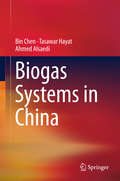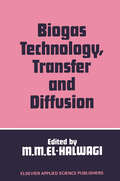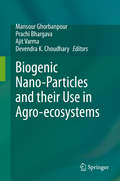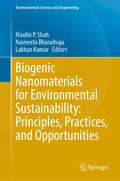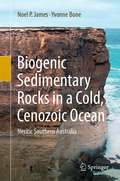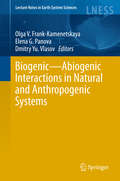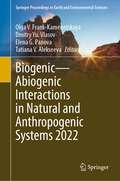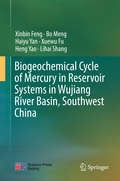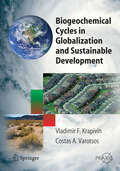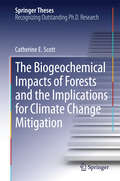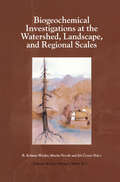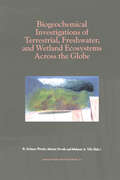- Table View
- List View
Biogas Science and Technology (Advances in Biochemical Engineering/Biotechnology #151)
by Georg Gübitz Alexander Bauer Guenther Bochmann Andreas Gronauer Stefan WeissMichael Lebuhn, Stefan Weiß, Bernhard Munk, Georg M. GuebitzMicrobiology and Molecular Biology Tools for Biogas Process Analysis, Diagnosis and ControlVeronika Dollhofer, Sabine Marie Podmirseg, Tony Martin Callaghan, Gareth Wyn Griffith & Katerina FliegerováAnaerobic Fungi and their Potential for Biogas ProductionBianca Fröschle, Monika Heiermann, Michael Lebuhn, Ute Messelhäusser, Matthias PlöchlHygiene and Sanitation in Biogas PlantsCharles-David Dubé and Serge R. GuiotDirect Interspecies Electron Transfer in Anaerobic Digestion: A ReviewSimon K.-M. R. RittmannA Critical Assessment of Microbiological Biogas to Biomethane Upgrading SystemsManfred Lübken, Pascal Kosse, Konrad Koch, Tito Gehring, Marc WichernInfluent Fractionation for Modeling Continuous Anaerobic Digestion ProcessesFermoso, F. G, van Hullebusch, E. D, Guibaud, G, Collins, G, Svensson, B. H, Carliell-Marquet, C, Vink, J.P.M, Esposito, G, Frunzo, LFate of Trace Metals in Anaerobic Digestion
Biogas Systems in China
by Bin Chen Tasawar Hayat Ahmed AlsaediThis book derives an explicit analytical pattern (or framework) that permits the examination and optimization of biogas production systems. It provides a concise overview of the current status of biogas and biogas coupled agricultural systems in China, and introduces evaluation methods for energy efficiency, environmental emissions, economic performance and sustainability assessment approaches. Based on empirical studies, it also explores future options for the system development by focusing on emissions mitigation, biogas energy efficiency and system sustainability. Systematic methods of life cycle assessment and thermodynamic analysis may provide new angles for biogas system evaluation. The system discussed is not only a biogas producer, but also a biogas-linked ecological agricultural system, which has the potential to broaden the applicable scopes of renewable energy and eco-agricultural management. The comprehensive, in-depth knowledge and experience presented provide new analytical approaches for researchers in relevant fields and shed light on the construction and operation of emerging anaerobic digestion and biogas industries. This book is a valuable resource for researchers focusing on biogas system modeling, project managers and policymakers.
Biogas Technology
by Liangwei Deng Yi Liu Wenguo WangThis book focuses on agricultural waste treatment and renewable energy production from the perspective of anaerobic digestion. It covers topics on anaerobic digestion processes and practices in various types of biogas plant construction and management and systematically addresses the principle and main features of three kinds of anaerobic digestion systems: household digesters, biogas septic tanks, and biogas plants. Instructive, informative and easy to understand, the book offers a valuable asset for researchers, technicians, graduate students and managerial personnel working in the areas of renewable energy, agricultural ecological engineering and the treatment and utilization of agricultural wastes.
Biogas Technology in Nigeria
by Isaac Nathaniel Itodo Eli Jidere Bala Abubakar Sani SamboThis book provides comprehensive and simplified coverage of fundamentals of biogas such as production, purification, storage, methods of improving yield and utilization, types, construction, design and operation of biogas plants. It covers stepwise design and a manual for construction of biogas plants including a planning guide, profitability analysis and evaluation of biogas plants. The biogas energy profile in Nigeria is exclusively covered. Features: Explores planning for biogas plants as a pre-requisite to develop a functional plant balancing energy production and consumption. Gives out detailed provision of the types of substances that are and can be used for biogas production covering animal, municipal, and industrial wastes. Provides knowledge for aspiring biogas producers as well as decision makers, specifically in the context of Nigeria. Covers use of digestrate for anaerobic digestion as a waste treatment method and on the input (feedstock) to the biogas plant. Compares carbon dioxide emissions from biogas plants with fossil fuel plants. This book aims at Graduate Students and Researchers in Agricultural, Environmental, Chemical, Civil and Energy engineering and related professional audience.
Biogas Technology in Nigeria
by Isaac Nathaniel Itodo Eli Jidere Bala Abubakar Sani SamboThis book provides comprehensive and simplified coverage of fundamentals of biogas such as production, purification, storage, methods of improving yield and utilization, types, construction, design and operation of biogas plants. It covers stepwise design and a manual for construction of biogas plants including a planning guide, profitability analysis and evaluation of biogas plants. The biogas energy profile in Nigeria is exclusively covered. Features: Explores planning for biogas plants as a pre-requisite to develop a functional plant balancing energy production and consumption. Gives out detailed provision of the types of substances that are and can be used for biogas production covering animal, municipal, and industrial wastes. Provides knowledge for aspiring biogas producers as well as decision makers, specifically in the context of Nigeria. Covers use of digestrate for anaerobic digestion as a waste treatment method and on the input (feedstock) to the biogas plant. Compares carbon dioxide emissions from biogas plants with fossil fuel plants. This book aims at Graduate Students and Researchers in Agricultural, Environmental, Chemical, Civil and Energy engineering and related professional audience.
Biogas Technology in Southeast Asia (Green Energy and Technology)
by Pruk Aggarangsi Sirichai Koonaphapdeelert Saoharit Nitayavardhana James MoranThis book on biogas is about the production and use of biogas with an emphasis on the raw materials and processes suitable for use in Southeast Asia. It is a gas formed when organic matter decomposes in an anaerobic digestion process. It can be made from any organic substance but the most economic are organic products from waste such as agricultural or general household waste, sewage, manure, municipal waste or food waste. As this raw material can be renewed indefinitely, biogas produced from it, is considered a renewable energy source. Worldwide interest in renewable energy sources is gathering momentum especially as concern for climate change mounts. Biogas generation helps reduce reliance on the use of fossil fuels. Producing biogas through biodigestion is non-polluting as there is no combustion or energy addition especially in the warmer climes of Southeast Asia. In this region, poorly managed landfills allow toxic liquids to drain into underground water sources. If instead, these wastes were used in a biogas plant, water pollution would be reduced. The same argument could be made for the local air quality. Therefore, biogas generation, in addition to producing renewable energy, also improves local water and air quality. The solid end-waste product of the biogas generation process is enriched natural organic matter (digestate), which can be substituted for chemical fertilizers, providing another environmental benefit to biogas. This book is primarily concerned with the production of biogas. From the raw material pre-treatment to the reactor design and operation to the post-treatment system, this book covers all aspects of production. There are many types of biogas reactors, each with their own advantages. Which reactor to select depends on the type and quantity of raw material, land area available and climate, among other factors. This book provides information on selecting and operating a suitable biogas system for interested parties be they governmental, NGO’s, private companies or individuals. Biogas contains primarily methane (CH4) and carbon dioxide (CO2). It may also contain small quantities of carbon monoxide (CO), hydrogen sulfide (H2S), moisture and siloxanes. Extracting the methane from all other gases is called biogas upgrading and the output is then referred to as biomethane. These upgrading processes are not the subject of this book as they are already the subject of a previously published book.
Biogas Technology, Transfer and Diffusion
by M. M.El-HalwagiThe International Conference on the State of the Art on Biogas Technology, Transfer and Diffusion was held in Cairo, Egypt, from 17 to 24 November 1984. The Conference was organized by the Egyptian Academy of Scientific Research and Technology (ASR T), the Egyptian National Research Centre (NRC), the Bioenergy Systems and Technology project (BST) of the US Agency for International Development (US/AID) Office of Energy, and the National Academy of Sciences (NAS). A number of international organizations and agencies co-sponsored the Conference. More than 100 participants from 40 countries attended. The purpose of the Conference was to assess the viability of biogas technology (BGT) and propose future courses of action for exploiting BGT prospects to the fullest extent. The Conference emphasized a balanced coverage of technical, environ mental, social, economic and organizational aspects relevant to biogas systems design, operation and diffusion. It was organized to incorporate experiences that are pertinent, for the most part, to developing countries. In addition to the wide spectrum of presentations and country programs, structured and non-structured discussions among the participants were strongly encouraged in thematic sessions at round-table discussions, and through personal contacts during poster sessions and field trips. It was clear from the enthusiastic response of most participants that the Conference, in large measure, succeeded in fulfilling its mission. Although draft papers were distributed to all participants, it was felt that the results obtained were worthy of organized and refined documentation. And this is precisely what this book intends to do.
Biogene Arzneistoffe: Entwicklungen auf dem Gebiet der Pharmazeutischen Biologie, Phytochemie und Phytotherapie
by Franz-C. CzyganBiogenesis Evolution Homeostasis: A Symposium by Correspondence
by Alfred LockerIn 1963, 1965 and 1967 "Symposia on Quantitative Biology of Metabolism" were organized on the pretty island of Helgoland (Biologische Anstalt) by me in col laboration with O. KINNE and F. KROGER. Unfortunately this worthy approach towards bringing together interested scholars in a regular way ceased, mainly for financial reasons, although the need for and interest in conferences like these for the exchange of ideas on special topics unchangeably persists. So I had to look for other possibilities and one of them was to try to arrange a similar con ference under the auspices of NASA. This institution, however, eventually re-. treated, although during my discussion with its representatives a new special theme gained shape. This is the topic to which this volume is devoted: Bio genesis. It is also treated in a new way that probably could be a model for. similar undertakings: a symposium by correspondence. In this new approach to scientific information exchange, manuscripts were collected by the editor and sent to every contributor for his comments. The author could then reply by means of a concluding remark. So, in many instances very valuable ideas concerning the topics of the several papers could be gathered and it is to be hoped that this procedure has conferred upon this volume a certain uniqueness. Of course, I had to observe the agreement with Springer-Verlag not to exceed the extent of the volume allotted to us.
Biogenic Nano-Particles and their Use in Agro-ecosystems
by Ajit Varma Devendra K. Choudhary Mansour Ghorbanpour Prachi BhargavaSeveral nano-scale devices have emerged that are capable of analysing plant diseases, nutrient deficiencies and any other ailments that may affect food security in agro-ecosystems. It has been envisioned that smart delivery systems can be developed and utilised for better management of agricultural ecosystems. These systems could exhibit beneficial, multi-functional characteristics, which could be used to assess and also control habitat-imposed stresses to crops.Nanoparticle-mediated smart delivery systems can control the delivery of nutrients or bioactive and/or pesticide molecules in plants. It has been suggested that nano-particles in plants might help determine their nutrient status and could also be used as cures in agro-ecosystems. Further, to enhance soil and crop productivity, nanotechnology has been used to create and deliver nano fertilizers, which can be defined as nano-particles that directly help supply nutrients for plant growth and soil productivity. Nano-particles can be absorbed onto clay networks, leading to improved soil health and more efficient nutrient use by crops. Additionally, fertilizer particles can be coated with nano-particles that facilitate slow and steady release of nutrients, reducing loss of nutrients and enhancing their efficiency in agri-crops. Although the use of nanotechnology in agro-ecosystems is still in its early stages and needs to be developed further, nano-particle-mediated delivery systems are promising solutions for the successful management of agri-ecosystems. In this context, the book offers insights into nanotechnology in agro-ecosystems with reference to biogenic nanoparticles. It highlights the: • occurrence and diversity of Biogenic Nanoparticles• mechanistic approach involved in the synthesis of biogenic nanoparticles• synthesis of nanoparticles using photo-activation, and their fate in the soil ecosystem• potential applications of nanoparticles in agricultural systems• application and biogenic synthesis of gold nanoparticles and their characterization• impact of biogenic nanoparticles on biotic stress to plants• mechanistic approaches involved in the antimicrobial effects and cytotoxicity of biogenic nanoparticles• role of biogenic nanoparticles in plant diseases management• relevance of biological synthesized nanoparticles in the longevity of agricultural crops • design and synthesis of nano-biosensors for monitoring pollutants in water, soil and plant systems• applications of nanotechnology in agriculture with special refer to soil, water and plant sciencesA useful resource for postgraduate and research students in the field of plant and agricultural sciences, it is also of interest to researchers working in nano and biotechnology.
Biogenic Nanomaterial for Health and Environment
by Rahul Badru Yadvinder Singh Narinder Singh Deepak DubalThe book titled Biogenic Nanomaterial for Health and Environment covers the synthesis, characterization, and applications of nanomaterials synthesized using living organisms, like bacteria, algae, fungi, plants, and biomolecules derived from them. This book is intended to meet the needs of undergraduate and graduate-level students of chemistry, biology, nanotechnology, and chemical engineering disciplines. The book will also serve as a useful reference work for researchers working in the fields of nanochemistry, material science, biology, and industrial chemistry. FEATURES A systematic overview of the biogenic synthesis nanomaterial. Recent research results and pointers to the advancement in the field. Discussion of putative applications of biogenic nanomaterials in health and the environment, with a main emphasis on biocidal activity, disease diagnosis, drug delivery, and sensing and remediation of pollutants from the environment. This book is compiled in such a way that it aids in understanding the underpinning concepts of the biogenic synthesis of nanoparticles. The biogenic synthesis of nanoparticles delivers more important and effective prospects for nanotechnology researchers. The biomass derived from various organisms acts as a template for the synthesis of nanoparticles with desired structural and featural aspects. The rewards of employing biomass and molecules derived from organism of choice in the synthesis process of nanoparticles are able to enhance the electrochemical consistency, control particle size, reduce toxicity, and escalate reactivity in an eco-friendly way. This book will provide the latest insights into the synthesis of nanomaterials employing biomass, cell extract, or as a whole, of various organisms and their roles in the health and remediation of the environment.
Biogenic Nanomaterial for Health and Environment
The book titled Biogenic Nanomaterial for Health and Environment covers the synthesis, characterization, and applications of nanomaterials synthesized using living organisms, like bacteria, algae, fungi, plants, and biomolecules derived from them. This book is intended to meet the needs of undergraduate and graduate-level students of chemistry, biology, nanotechnology, and chemical engineering disciplines. The book will also serve as a useful reference work for researchers working in the fields of nanochemistry, material science, biology, and industrial chemistry. FEATURES A systematic overview of the biogenic synthesis nanomaterial. Recent research results and pointers to the advancement in the field. Discussion of putative applications of biogenic nanomaterials in health and the environment, with a main emphasis on biocidal activity, disease diagnosis, drug delivery, and sensing and remediation of pollutants from the environment. This book is compiled in such a way that it aids in understanding the underpinning concepts of the biogenic synthesis of nanoparticles. The biogenic synthesis of nanoparticles delivers more important and effective prospects for nanotechnology researchers. The biomass derived from various organisms acts as a template for the synthesis of nanoparticles with desired structural and featural aspects. The rewards of employing biomass and molecules derived from organism of choice in the synthesis process of nanoparticles are able to enhance the electrochemical consistency, control particle size, reduce toxicity, and escalate reactivity in an eco-friendly way. This book will provide the latest insights into the synthesis of nanomaterials employing biomass, cell extract, or as a whole, of various organisms and their roles in the health and remediation of the environment.
Biogenic Nanomaterials: Structural Properties and Functional Applications (Innovations in Biotechnology)
by Devarajan ThangaduraiNanotechnology is believed to be the next great revolution in biology, medicine, and agriculture. This new volume, Biogenic Nanomaterials: Structural Properties and Functional Applications, explores that trend by providing in a global way updated information on the use and applications of nanobiotechnology, starting from a careful characterization and introduction to the various uses of nanoparticles and nanomaterials, their nanomechanical properties in bacteria, and biomedical applications. The book goes on to present nanobiotechnology applications in targeted therapy for multiple pathologies, such as cancer, obstructive pulmonary diseases, chronic infectious diseases, as well as its impact on the modulation of the intestinal microbiota. A special emphasis is also given to the potential of nanobiotechnology in terms of promoting sustainability, such as the ability to improve plant systems in terms of tissue culture, its added value in the transfer of macromolecules to plants, and also in triggering the sustainable exploitation of agriculture, forestry, and food residues, ultimately promoting green nanotechnology. This book offers a unique perspective and overview of the influences of nanobiotechnology researchers and scientists. It delivers an important resource for existing applications and imminent developments of nanobiotechnology.
Biogenic Nanomaterials: Structural Properties and Functional Applications (Innovations in Biotechnology)
by Devarajan Thangadurai Saher Islam Jeyabalan Sangeetha Natália Cruz-MartinsNanotechnology is believed to be the next great revolution in biology, medicine, and agriculture. This new volume, Biogenic Nanomaterials: Structural Properties and Functional Applications, explores that trend by providing in a global way updated information on the use and applications of nanobiotechnology, starting from a careful characterization and introduction to the various uses of nanoparticles and nanomaterials, their nanomechanical properties in bacteria, and biomedical applications. The book goes on to present nanobiotechnology applications in targeted therapy for multiple pathologies, such as cancer, obstructive pulmonary diseases, chronic infectious diseases, as well as its impact on the modulation of the intestinal microbiota. A special emphasis is also given to the potential of nanobiotechnology in terms of promoting sustainability, such as the ability to improve plant systems in terms of tissue culture, its added value in the transfer of macromolecules to plants, and also in triggering the sustainable exploitation of agriculture, forestry, and food residues, ultimately promoting green nanotechnology. This book offers a unique perspective and overview of the influences of nanobiotechnology researchers and scientists. It delivers an important resource for existing applications and imminent developments of nanobiotechnology.
Biogenic Nanomaterials for Environmental Sustainability: Principles, Practices, and Opportunities (Environmental Science and Engineering)
by Maulin P. Shah Navneeta Bharadvaja Lakhan KumarEnvironmental pollution is a worldwide concern now. A major section of the world population is struggling for drinking water. Polluted soil is resulting into low agricultural productivity and thus creating challenges in the way of sustainable livelihood of a large section of human population. Biological treatment can offer both green solutions for wastewater treatment and resource recovery as well. Like algal-based systems can be utilized for wastewater treatment and production of biofuels from the biomass grown on the wastewater. Bio-based nanomaterials have been extensively studied for their employability in the health care, process optimization, water resource management, dealing with environmental pollutants, biosensors, and many others. Bioprospecting of novel biological agents, bio-based products, and bioresource recovery are paving the way for sustainable development as they are providing local solutions for a number of problems.In this proposed book, we start with the introduction to bio-nanotechnological principles and later on discuss bio-based nanomaterials employability for a diverse range of applications from environment to energy to health care. This book provides with current trends in bio-nanotechnology for anthropogonic purposes, prospects, challenges, and way forward.
Biogenic Sedimentary Rocks in a Cold, Cenozoic Ocean: Neritic Southern Australia
by Noel P. James Yvonne BoneThis book documents and interprets the onshore Cenozoic temperate carbonate depositional system along the southern margin of Australia. These strata, deposited in four separate basins, together with the extensive modern marine system offshore, comprise the largest such cool-water carbonate system on the globe. The approach is classic and comparative but the information is a synthesis of recent research and new information. A brief section of introduction outlines the setting, modern comparative sedimentology offshore, and structure of the Cenozoic onshore. The core of the book is a detailed analysis and illustration of the four Eocene to Pleistocene successions. Deposits range from temperate carbonates, to biosiliceous spiculites, to marginal marine siliciclastics. Each unit is interpreted, as much as possible, based on our understanding of the modern offshore depositional system. A subsequent part concentrates on diagenesis both before and after the late Miocene uplift. It turns out that alteration in the two packages is entirely different. The preceding attributes of each succession are then interpreted on the basis of controlling factors such as tectonics, oceanography, climate, and glaciation of nearby Antarctica. This research has revealed new implications for the interpretation of specific attributes of cool-water carbonate sedimentology that could only be discovered from the rock record. Insights concerning cyclicity, reef mounds, biosiliceous deposition, and trophic resources are detailed in the next section. The concluding part focuses on global comparisons, especially the Mediterranean and New Zealand.
Biogenic Trace Gases: Measuring Emissions from Soil and Water
by P. A. Matson R. C. HarrissTrace gases are those that are present in the atmosphere at relatively low concentrations. Small changes in their concentrations can have profound implications for major atmospheric fluxes, and thereore, can be used as indicators in studies of global change, global biogeochemical cycling and global warming. This new how-to guide will detail the concepts and techniques involved in the detection and measurement of trace gases, and the impact they have on ecological studies. Introductory chapters look at the role of trace gases in global cycles, while later chapters go on to consider techniques for the measurement of gases in various environments and at a range of scales. A how-to guide for measuring atmospheric trace gases. Techniques described are of value in addressing current concerns over global climate change.
Biogenic—Abiogenic Interactions in Natural and Anthropogenic Systems: Abiogenic Interactions In Natural And Anthropogenic Systems (Lecture Notes in Earth System Sciences)
by Olga V. Frank-Kamenetskaya Elena G. Panova Dmitry Yu. VlasovThis book offers a collection of papers presented at the V International Symposium "Biogenic - abiogenic interactions in natural and anthropogenic systems" that was held from 20-22 October 2014 in Saint Petersburg (Russia). Papers in this book cover a wide range of topics connected with interactions between biogenic and abiogenic components in the lithosphere, biosphere and technosphere. The main topics include: biomineralization in geosystems, geochemistry of biogenic-abiogenic systems, biomineral interactions in soil, minerals in living organisms and biomimetic materials, medical geology, bioweathering and destruction of cultural heritage.
Biogenic—Abiogenic Interactions in Natural and Anthropogenic Systems 2022 (Springer Proceedings in Earth and Environmental Sciences)
by Olga V. Frank-Kamenetskaya Dmitry Yu. Vlasov Elena G. Panova Tatiana V. AlekseevaThe book represents a collection of papers presented at VII International Symposium "Biogenic-abiogenic interactions in natural and anthropogenic systems" that was held on 26-29 September 2022 in Saint Petersburg (Russia). Papers in this book cover a wide range of topics connecting with interactions between biogenic and abiogenic components in lithosphere, biosphere and technosphere. The main regarding topics are following: biomineralization in living organisms and nature-like materials; biomineralization in geosystems; geochemistry of biogenic-abiogenic systems; biomineral interactions in soil; interaction of microorganisms with natural and artificial materials; medical geology; philosophical aspects of interdisciplinary researchs
Biogeochemical Cycle of Mercury in Reservoir Systems in Wujiang River Basin, Southwest China
by Xinbin Feng Bo Meng Haiyu Yan Xuewu Fu Heng Yao Lihai ShangThis book presents an intensive study on the biogeochemical cycle of mercury in a river-reservoir system in Wujiang River Basin, the upper branch of the Yangtze River. Six reservoirs located in the mainstream of the Wujiang River and their corresponding inflow/outflow rivers were selected for inclusion in this study, which was conducted by researchers from the Institute of Geochemistry, Chinese Academy of Sciences. The concentration and distribution of Hg in reservoirs (the water column, sediment, sediment pore water), inflow/outflow rivers of reservoirs, and wet deposition in Wujiang River Basin were systematically investigated, and measurements were taken of the water/air exchange flux of gaseous elemental mercury (GEM). On the basis of the data gathered, a detailed mass balance of total mercury (THg) and methylmercury (MeHg) in the six reservoirs was developed. In addition, the book identifies the primary factors controlling Hg methylation in the river-reservoir system in Wujiang River Basin. The accumulation and bio-magnification of Hg species within food chains in reservoirs and human health risk of MeHg exposure through fish consumption are also included in this book.
Biogeochemical Cycles in Globalization and Sustainable Development (Springer Praxis Books)
by Vladimir F. KrapivinThis book presents a new approach to the study of global environmental changes that have unfavorable implications for people and other living systems. The book benefits from the accumulation of knowledge from different sciences. Basic global problems of the nature-society system dynamics are considered. The book aims to develop a universal information technology to estimate the state of environmental subsystems functioning under various climatic and anthropogenic conditions.
Biogeochemical Cycling and Sediment Ecology (NATO Science Partnership Subseries: 2 #59)
by J. Gray William Ambrose Jr. Anna SzaniawskaOceanographic discontinuities (e. g. frontal systems, upwelling areas, ice edges) are often areas of enhanced biological productivity. Considerable research on the physics and biology of the physical boundaries defining these discontinues has been accomplished (see [I D. The interface between water and sediment is the largest physical boundary in the ocean, but has not received a proportionate degree of attention. The purpose of the Nato Advanced Research Workshop (ARW) was to focus on soft-sediment systems by identifying deficiencies in our knowledge of these systems and defining key issues in the management of coastal sedimentary habitats. Marine sediments play important roles in the marine ecosystem and the biosphere. They provide food and habitat for many marine organisms, some of which are commercially important. More importantly from a global perspective, marine sediments also provide "ecosystem goods and services" [2J. Organic matter from primary production in the water column and contaminants scavenged by particles accumulate in sediments where their fate is determined by sediment processes such as bioturbation and biogeochemical cycling. Nutrients are regenerated and contaminants degraded in sediments. Under some conditions, carbon accumulates in coastal and shelf sediments and may by removed from the carbon cycle for millions of years, having a potentially significant impact on global climate change. Sediments also protect coasts. The economic value of services provided by coastal areas has recently been estimated to be on the order of $12,568 9 10 y" [3J, far in excess of the global GNP.
The Biogeochemical Impacts of Forests and the Implications for Climate Change Mitigation (Springer Theses)
by Catherine E. ScottForests and vegetation emit biogenic volatile organic compounds (BVOCs) into the atmosphere which, once oxidized, can partition into the particle phase, forming secondary organic aerosols (SOAs). This thesis reports on a unique and comprehensive analysis of the impact of BVOC emissions on atmospheric aerosols and climate. A state-of-the-art global aerosol microphysics model is used to make the first detailed assessment of the impact of BVOC emissions on aerosol microphysical properties, improving our understanding of the role of these emissions in affecting the Earth’s climate. The thesis also reports on the implications for the climate impact of forests. Accounting for the climate impacts of SOAs, taken together with the carbon cycle and surface albedo effects that have been studied in previous work, increases the total warming effect of global deforestation by roughly 20%.
Biogeochemical Investigations at Watershed, Landscape, and Regional Scales: Refereed papers from BIOGEOMON, The Third International Symposium on Ecosystem Behavior; Co-Sponsored by Villanova University and the Czech Geological Survey; held at Villanova University, Villanova Pennsylvania, USA, June 21–25, 1997
by R. Kelman Wieder Martin Novák Jiří ČernýThis Special Issue of Water, Air, and Soil Pollution offers original contributions from BIOGEOMON, The Third International Symposium on Ecosystem Behavior, which was held on the campus ofVillanova University from June 21-25, 1997. Previous meetings were held in Prague in 1987 and again in 1993. The BIOGEOMON series was initiated in 1987 when a group of researchers from the Czech Geological Survey organized a conference called GEOMON, Geochemical Monitoring in Representative Basins. GEOMON was fairly narrowly focused on monitoring of element pools and fluxes on a small watershed scale. As signalled by the change in name to BIOGEOMON, the second conference explicitly recognized that assessment of anthropogenic effects on ecosystem processes requires a combination of geochemical monitoring with other approaches, including watershed-level manipulations, use of radioactive and stable isotopic tracers, and both empirical and process modeling. The 1997 BIOGEOMON conference was the largest, with over 240 participants from 28 countries on five continents in attendance, and broadest in scope. The conference featured a plenary speaker, six keynote speakers, 35 invited speakers, over 60 oral contributed presentations, and over 75 poster presentations.
Biogeochemical Investigations of Terrestrial, Freshwater, and Wetland Ecosystems across the Globe
by R. Kelman Wieder Martin Novák Melanie A. VileHere is a collection of papers from BIOGEOMON, The Fourth International Symposium on Ecosystem Behavior. The contributions address a wider-than-ever range of concerns: aspects of catchment monitoring and modeling; nitrogen transformations and processes; stable and radiogenic isotopes; biogeochemistry of restored ecosystems; and the dynamics of such chemicals as mercury and phosphorous, among many other topics.

